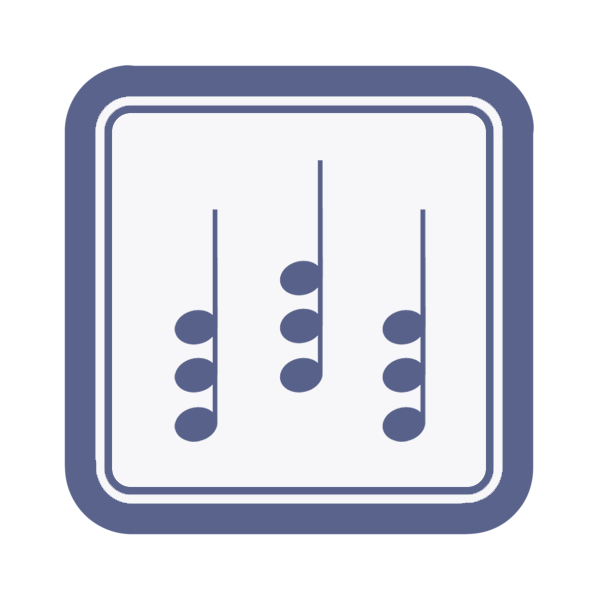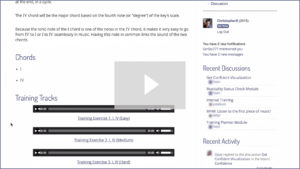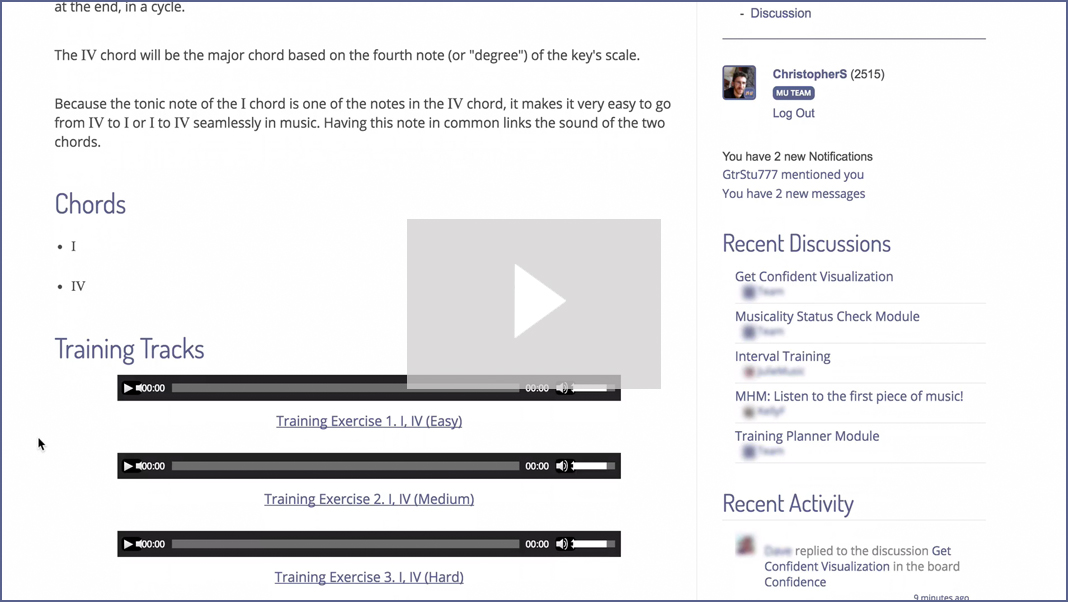Play Chords By Ear Mini-Course
Lesson 4: Adding the Five (Seven?)
This lesson is based on the Chord Progression Recognition module from Musical U.
Not yet a member? Click here to preview the module.
You already know that the I, IV and V chords are the most important in music, and hopefully you’ve now made a start at telling the I and IV apart.
It’s time to add in the V chord – but to make things easier we’re actually going to do it in a few stages.
The first stage is to introduce the V7 chord (pronounced simply “five seven”). This is a special version of the V chord which adds in the seventh note of the scale…
Why does that help?
Well, as you’ll learn in today’s lesson, the V7 chord is very distinctive, which means you can recognise it more easily as different from the I and IV. More on that below!
As before, you can listen to the tracks provided directly, or download them to practice with later (on your computer or any mobile device). To do that just right-click the track name and choose “Save As” to download the MP3 file.
LEARN
1. The I and V7 chords
Now let’s introduce a third chord: the V7.
Normally we talk about “I, IV, V” progressions. So what’s the V7?
The answer is that it’s a special 4-note version of the more common V chord.
The V chord is often referred to as the ‘dominant’ chord, which is a good word for how it sounds: powerful, imposing. It creates a tension that forces the human ears to impatiently wait for a more relaxed tonic sound – such as IV or I.
Music is all about tension and release, and the V chord is essential to create a tension. It gives a natural reason to go back to the I chord to end a progression.
So that’s the V. What about the V7? This chord adds the seventh note of the scale to the V chord, creating an even more dissonant sound, and strongly makes you feel like it needs a resolution to complete the sequence.
We’ll use the V7 as a stepping-stone to recognise the regular V chord, because it will be easier for you to recognise this dissonant V7 among the I and IV chords you already know.
2. The I, IV and V7 chords
Once you’re familiar with the I, IV and V7 chords, it’s time to try mixing them together.
Can you still recognise each chord in these progressions which use all three?
There are tracks below for I, IV, V7 practice.
3. The I, IV and V chords
Finally it’s time to replace the V7 chord with the regular V triad chord.
This will make it a bit harder for you to recognise the chord progressions because the V chord blends in much more with the I and IV than the more striking V7.
However, the skills you’ve now built up should help you to recognise the V. If you have difficulty you can go back and practice with the V7 some more.
PRACTICE
Step 1: Train
Use these “Training” tracks to listen carefully to examples of progressions and tune your ear in to the sound of each chord.
Each time you will hear the scale and then a progression is played. It is then announced so you know which chords you’re hearing.
1. Listen:
2. Listen:
3. Listen:
Step 2: Test
Once you think you’re getting a sense of the chords, listen to the corresponding “Test” track, which includes a short pause after each progression.
During the pause, try to identify the chords you just heard.
You’ll hear the correct answer so you know if you got it right and have the chance to hear the progression again.
1. Listen:
2. Listen:
3. Listen:
Remember: You shouldn’t aim for perfection with these exercises at this stage.
It takes time to develop your musical ear, and these are just a small subset of the full exercises you should use. In this mini-course your goal should be just to start waking your ears up to these chords. That will be enough to start playing a few songs by ear! You can then use the full training modules inside Musical U if you want to really master playing chords by ear.
APPLY
Let’s try using your new I-IV-V skills with another classic song: Wild Thing by The Troggs.
This is a good song to practice listening for the I-IV-V transitions.
It’s not time to try playing it directly by ear yet (though you can try if you like!)
Instead use this hint and then try playing it by ear:
Hint: The song is in the key of A and the lines of verse each use the following progression with two strums on each chord: I IV V IV
(For now, ignore the “Wild Thing, I think I love you” section.)
If you need to look up the I, IV and V chords in A, refer back to Lesson 2 of this mini-course.
Try playing along on your instrument!
In the next lesson we’re going to move from the simple training exercises you’ve been using to some more realistic music practice with I-IV-V progressions in different styles!
“Chords By Ear”
email mini-course
Not signed up yet?
Click here
Discussion
Musical U membership includes full personal support and guidance on your training.
Although we can’t provide the same level of in-depth coaching as part of this free course, please post any questions you have in the comments below and we’ll do our best to help!




 This free lesson is based on the Chord Progression Recognition module of Musical U.
This free lesson is based on the Chord Progression Recognition module of Musical U.